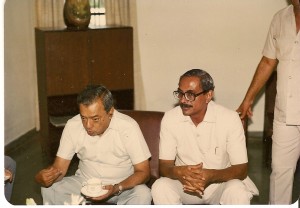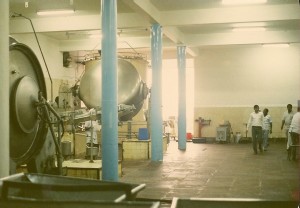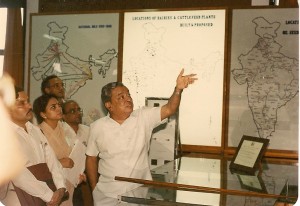Two Outstanding Experiments in Social Development
“You would like to know about China’s experience. ………………. Thus the primary thing we’ve learned from our experience and that we would like to propose to our third-world friends is self-reliance. Of course, that doesn’t mean we shouldn’t seek outside help, but the main thing is to rely on our own efforts. Through self-reliance we can unite the people, inspire the whole country to work hard for prosperity, and thus make it easier to overcome the many difficulties in the way.”
Deng Xiaoping’s advice to Liberian head of state, Samuel Kanyan Doe, on 06 May, 1982, at a meeting in Beijing. Quoted from Selected Works of Deng Xiaoping, Vol. 2, Foreign Languages Press, Beijing, China, 1995.
Ideological idiocy
In 1992 a man named Francis Fukuyama wrote a book titled The End of History and the Last Man. A US Department of State employee, he hailed the collapse of Soviet Communism in 1990/91 and proclaimed that Western liberal democracy represented the zenith of political evolution and was the ultimate state for mankind. He was not a pioneer. Many others before him, including Marxists and Soviet Communists, have made similar claims. He will not be last.
But the progress of human civilization has been due to man’s unique capacity to experiment, innovate and make choices for his betterment. No scientist believes that extant knowledge provides the final answer and hence continuous research and experimentation has enabled us to achieve our present level of development. Yet in two important areas of life, politics and religion, large portions of mankind are stuck in ideological grooves invented a few hundred or a few thousand years ago.
Capitalists, communists, socialists, conservatives, liberals, leftists, rightists, centrists, all of these under the umbrella of the holy grail of democracy and progress – these commonly bandied terms usually represent the political junk popularised by conniving politicians and their supporting media in their quest for power. They have different meanings for different occasions. For example, American democracy and British or French democracy widely differ and work differently. A US legislature influenced by 37,000 highly paid lobbyists for powerful special interests (largely big corporations) offering campaign finance and other incentives would not be considered part of a democratic system either in Europe or even in many developing nations.
When one billion people around the world live in dire poverty and even 13% of Americans are poor[1] and often hungry and 50 million Americans are without access to health care[2], the world could not have invented an ideal socio-economic model as yet. This is why it is important to publicise any successful large-scale projects in socio-economic engineering outside of the mainstream systems that the international media pays scant attention to. I want to draw attention to two such outstanding experiments, one in India and the other in China. Both are brainchildren of two revolutionary figures.
An Indian experiment
India began its new experiment in living when Mahatma Gandhi’s concept of simple rural living and high thinking caught the imagination of Indians in their struggle for independence against British imperialists. Gandhi’s ritual cotton spinning and handloom cloth and disdain for imported manufactured products caught the imagination of the Indian masses and mobilised them into mass action. Bur a modern society cannot be sustained by primitive cottage industries. Pragmatic Indian Congress leaders recognised that it was not a panacea for India’s terrible poverty and they created the basis for a new industrial society after Gandhi passed away. But India remained, and still remains, a deeply divided nation, with state of the art industries and some of the world’s richest people together with 300 million of the world’s poorest people, mainly small farmers living in a semi-feudal rural society. It shows that market-based capitalism without a concern of the under-privileged is seriously flawed and hence the endless conflicts within Indian society.
The most successful large-scale experiment in empowering poor small farmers, who constitute the largest portion of Indian society, began in 1946 in a small village called Anand in Gujarat. Dr. Verghese Kurien, a young government engineer, was sent to this place to work on a government project but became more involved in helping the poor local farmers struggling for survival on small plots of land with a few head of cattle. He gave up his prized job and organised a dairy cooperative which comprised dairy farmers in and around Anand called the Gujarat Farmer’s Cooperative Union. The success of the cooperative in Anand was replicated in other neighbouring villages in Gujarat and today this alliance of cooperatives has become the Gujarat Cooperative Milk Marketing Federation, which encompasses a shareholding by 2.8 million small dairy producers in Gujarat, India. It has become the leading Indian dairy products corporation with a current annual turnover of US$1.8 billion. Its Amul brand dairy products are distributed throughout India and also exported to some countries.
I visited the facilities in Anand and Dr. Kurien joining a group from the Indian Institute of Management of Ahmedabad in 1987 and again in 1988. Dr. Kurien and his wife, who prepared an excellent Indian lunch for us, lived in a comfortable modern house. To the Indian members of our team visiting the place for the first time, improving the lives of the poor was indelibly associated with Gandhi and his philosophy of life. So they questioned whether he was a vegetarian and teetotaller: to which he replied that he enjoyed his whisky and meat. He then made it plain that the success of the cooperative was due to its modern industrial technologies and highly paid professional management combined with equal shareholding for all dairy-farming members.
We visited the large modern factories in Anand. Milk collection vans went out daily to the rural households with a few cows to obtain small volumes of fresh milk. These were first tested for fat content and accepted. Payment was made for each collection the next day. The cooperative also provided the farmers with veterinary services, feed supplements and better breeding stock. In the factories, milk was sterilized, refrigerated and pumped from large overhead silos into railway tankers which set out daily for the big urban markets in Delhi, Kolkatta and Bombay. In other plants, milk was converted to butter, cheese and yoghurt and packed under the Amul name. There was a substantial allocation for marketing: market research, product distribution, packaging, media advertising and pricing. Like any modern industrial corporation, the business was working with food distributors, market research firms, advertisers and other national service providers.
Part of the corporate philosophy was also to provide low cost products for poor consumers. Low priced milk was sold in a unique way by eliminating packaging. Chilled milk dispensers were set up in stores in low income areas where consumers could bring their own containers and buy the quantity of milk they could afford. The milk vending machines were operated by consumers using token coins they could buy from the store.
China and “The World’s Richest Village”
The other remarkable new experiment in cooperative living comes from China. Prior to 1949, China was nominally governed by the rapacious Kuomintang regime of Chiang Kai-shek, while large swathes of this vast country was controlled by warlords paying nominal allegiance to the central government. The Chinese communist revolution set out to create a new egalitarian communist society but Mao Zedong’s authoritarian rule and increasingly eccentric mind created two of the world’s worst socio-economic experiments – the Great Leap Forward and the Cultural Revolution – in which millions of people died of starvation or were tortured to death through hard labour and physical punishment. Sanity and progress came only after Mao’s death in 1976. These were two of the worst ideologically based experiments in human history because the scale of it involved several hundred million people. Since then China has seen the world’s fastest economic growth and social development but market-based capitalism has produced the traditional ills of capitalism with the growing divide between the rich and the poor.
So the story of Huaxi, or “The Richest Village in the World”, is something that needs to be studied by economists and sociologists. The media published it in passing as a sensational story but it remains largely unknown to the world at large[3]. The story of Huaxi village begins in the 1990s when it was a very poor farming village with dirt roads and bamboo and wattle houses. With Deng Xiaoping’s market-based economic reforms and more open government, the local Communist Party leader, Wu Ren Bao[4], created a corporation in which all the local villagers became shareholders and set out to modernise its agriculture. The profits generated by the corporation were then used to invest in modern manufacturing units, mainly textiles and then steel. Steel manufacture and export, based on the import of raw material from India and Brazil, now accounts for half the business of this corporation.
Huaxi is not just another cooperative like the thousands that are found in Europe and America. Nor is it akin to the small communes sometimes found in the US where idealistic people who have opted out of the mainstream live simple lives with basic amenities. It is a new experiment in living designed for a comfortable modern life in an egalitarian society. The corporation is governed by a rigid moral code and work ethic. From the huge profits the business generated, the shareholders receive good salaries and substantial benefits. Villa-type house have now been built for all members. They are furnished with all mod-cons. Each family is entitled to a car at corporate expense: and the cars are usually luxury vehicles like Mercedes, BMW and Cadillac. Each family has a bank account with an average $250,000 in savings. They have free education and free health services. The village has good roads, landscaped open areas, good schools and hospitals, and museums and monuments symbolic of other countries which locals still cannot visit. Huaxi village allows non-residents to set up business in the locality but they have no access to the special benefits the members of the corporation obtain.
These benefits come with a strict moral code of conduct: no picking of any public property, no littering, and a 7 seven day work week with no holiday week-ends. A worker may obtain leave for a special occasion for a day. Morale is kept high with socialist propaganda. Inspirational songs are publicly broadcast praising communism and the covered walkways for pedestrians are lined with Confucian and other Chinese philosophic quotations.
Huaxi is not a passing phenomenon. Its success is mind-boggling. The annual turnover of this village corporation is now over US$70 billion. The corporation was quoted in the Shanghai Stock Exchange since 1995. It is a powerful corporation run on the best business practices and high moral principles for the good of its 36,000 members. With expanding manufacturing and the new business investments by outside investors that have flowed in, the village now employs another 60,000 or more migrant workers who do not share the same benefits, except for access to public education and health services. It is perhaps the most unique socio-economic experiment in modern history.
Kenneth Abeywickrama
30 December 2010.
[1] See webpage of Bread for the World at http://www.bread.org/hunger/us/?utm_source=adwords&utm_medium=onlinead&utm_campaign=search&utm_term=us-poverty&utm_content=text&gclid=CN605Z_qh6YCFcnc4AodpA23nA
[2] Report by Kaiser Foundation
[3] See
http://www.bbc.co.uk/news/world-asia-pacific-12005026
http://www.youtube.com/watch?v=yru1C-RE7lc
http://www.youtube.com/watch?v=OFWQ0uTHdxc
http://www.reuters.com/article/idUSPEK28591120071122
[4] Wu was a revolutionary and non-conformist. He was tortured during the Cultural Revolution as a “Capitalist Roader” and later criticized seeking private ownership of land by farmers.




5 Responses to Welcome